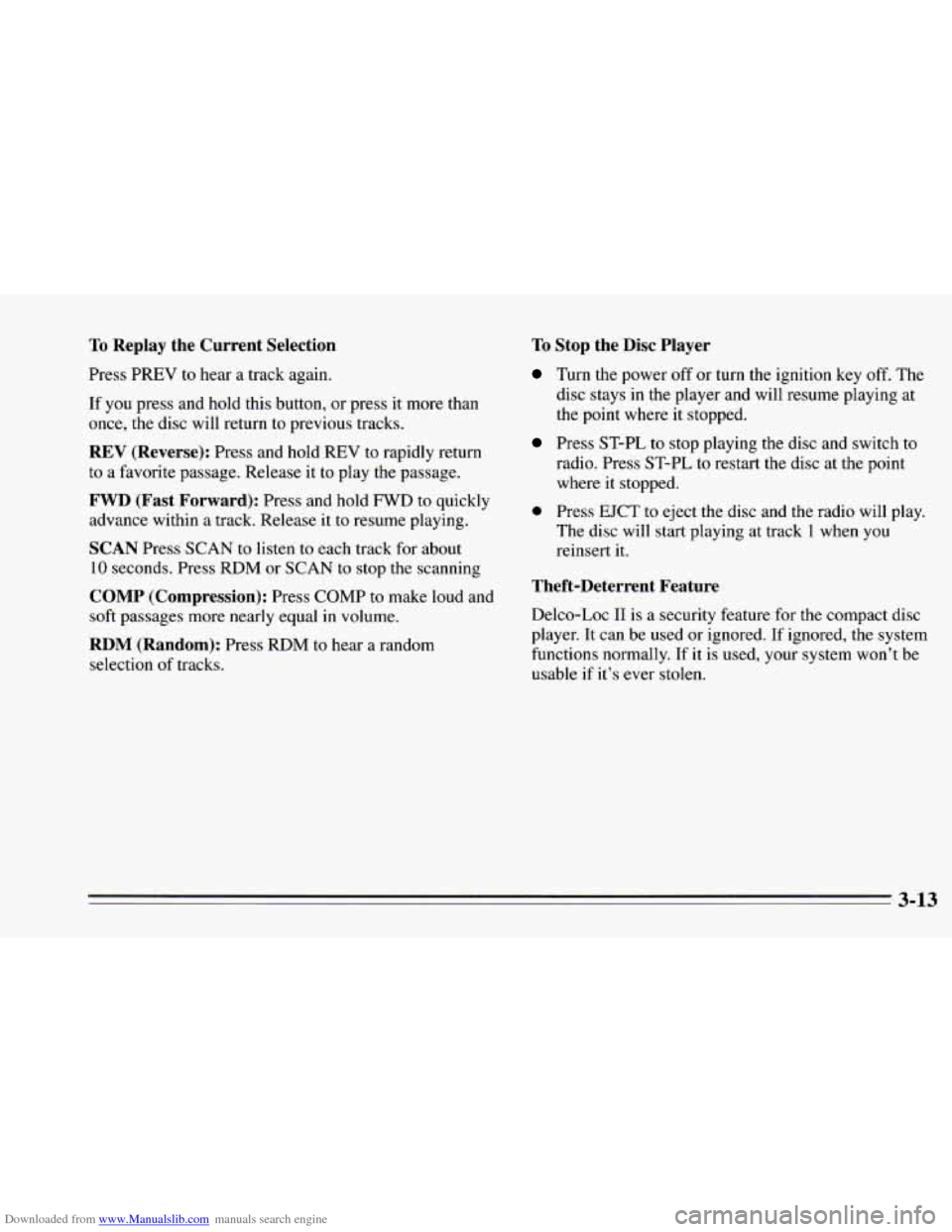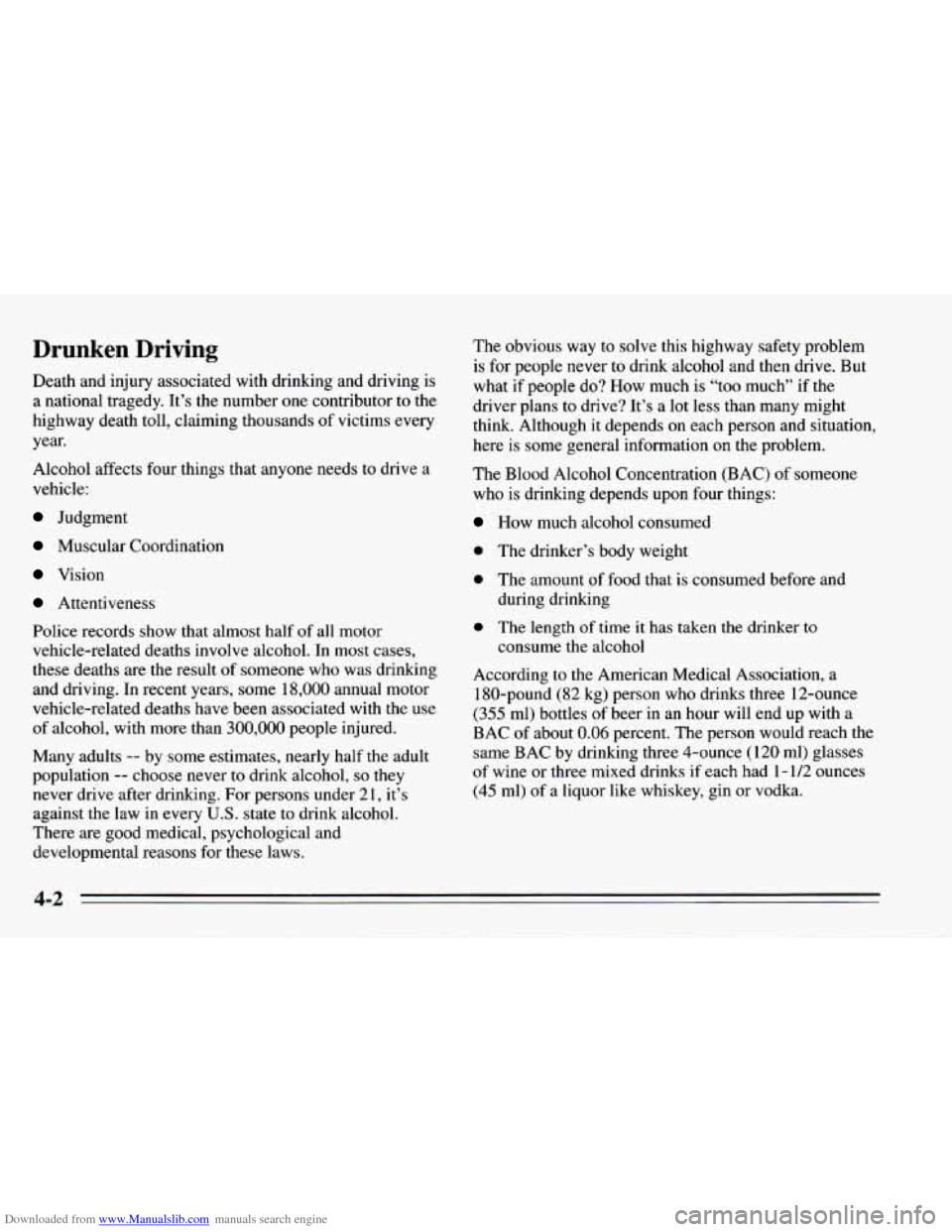Page 120 of 388

Downloaded from www.Manualslib.com manuals search engine Warning lights come on when there may be or is a
problem with
one of your vehicle’s functions. As you
will see in the details on the next few pages, some
warning lights come on briefly when you start the
engine just to let you know they’re working. If
you are
familiar with this section, you should not be alarmed
when this happens.
Gages can indicate when there may be
or is a problem
with one of your vehicle’s functions. Often gages and
warning lights work together to let you know when
there’s a problem with your vehicle.
When
one of the warning lights comes on and stays on
when
you are driving, or when one of the gages shows
there may be
a problem, check the section that tells you
what to do about it. Please follow this manual’s advice.
Waiting to do repairs can be costly
-- and even
dangerous.
So please get to know your warning lights
and gages. They’re a
big help.
Safety Belt Reminder Light
When the key is turned to RUN or START, a tone will
come
on for about eight seconds to remind people to
fasten their safety belts, unless the driver’s safety belt is
already buckled. The safety belt light will also come
on
and stay on until the driver’s belt is buckled.
2-68
Page 137 of 388
Downloaded from www.Manualslib.com manuals search engine If your vehicle suffers a power loss, such as a dead
battery, you can still raise
the top manually by rotating
the valve in the left side
of the trunk.
Open the trunk and find the tab along the left side trim
panel. Lift up the tab and
turn the valve clockwise to
release the hydraulic pressure. Turn the ignition key to
the LOCK position. You can now raise or lower your top
manually. Be sure to close the valve after installing your
top
so you can raise or lower it electronically later.
6. Pull down on the latches and align hooks with holes.
Push forward on the larger part
of the latch until it
clicks.
Do not force the latch. If it is hard to lock, the
top
is not properly aligned.
2-85
Page 151 of 388

Downloaded from www.Manualslib.com manuals search engine To Replay the Current Selection
Press PREV to hear a track again.
If you press and hold this button, or press it more than
once, the disc will return to previous tracks.
REV (Reverse): Press and hold REV to rapidly return
to a favorite passage. Release it to play the passage.
FWD (Fast Forward): Press and hold FWD to quickly
advance within
a track. Release it to resume playing.
SCAN Press SCAN to listen to each track for about
10 seconds. Press RDM or SCAN to stop the scanning
COMP (Compression): Press COMP to make loud and
soft passages more nearly equal
in volume.
RDM (Random): Press RDM to hear a random
selection of tracks.
To Stop the Disc Player
Turn the power off or turn the ignition key off. The
disc stays in the player and will resume playing at
the point where it stopped.
Press ST-PL to stop playing the disc and switch to
radio. Press ST-PL to restart the disc at the point
where it stopped.
0 Press EJCT to eject the disc and the radio will play.
The disc will start playing at track
1 when you
reinsert it.
Theft-Deterrent Feature
Delco-Loc I1 is a security feature for the compact disc
player. It can be used or ignored. If ignored, the system
functions normally.
If it is used, your system won’t be
usable
if it’s ever stolen.
3-13
Page 158 of 388

Downloaded from www.Manualslib.com manuals search engine Drunken Driving
Death and injury associated with drinking and driving is
a national tragedy. It’s the number one contributor to the
highway death toll, claiming thousands of victims every
year.
Alcohol affects four things that anyone needs to drive
a
vehicle:
Judgment
Muscular Coordination
Vision
Attentiveness
Police records show that almost half of all motor
vehicle-related deaths involve alcohol. In most cases,
these deaths are the result
of someone who was drinking
and driving.
In recent years, some 18,000 annual motor
vehicle-related deaths have been associated with the use
of alcohol, with more than 300,000 people injured.
Many adults
-- by some estimates, nearly half the adult
population
-- choose never to drink alcohol, so they
never drive after drinking. For persons under 2
I, it’s
against the law in every
U.S. state to drink alcohol.
There
are good medical, psychological and
developmental reasons for these laws. The
obvious way to solve this highway safety problem
is for people never to drink alcohol and then drive. But
what if people do?
How much is “too much’’ if the
driver plans to drive? It’s a lot less than many might
think, Although it depends on each person and situation,
here
is some general information on the problem.
The Blood Alcohol Concentration
(BAC) of someone
who is drinking depends upon four things:
How much alcohol consumed
0 The drinker’s body weight
0 The amount of food that is consumed before and
during drinking
0 The length of time it has taken the drinker to
consume the alcohol
According
to the American Medical Association, a
180-pound (82 kg) person who drinks three 12-ounce
(355 ml) bottles of beer in an hour will end up with a
BAC of about 0.06 percent. The person would reach the
same
BAC by drinking three 4-ounce (120 ml) glasses
of wine or three mixed drinks if each had 1 - 1/2 ounces
(45 ml) of a liquor like whiskey, gin or vodka.
4-2
Page 195 of 388
Downloaded from www.Manualslib.com manuals search engine 0 Section 5 Problems on the Road
Here you’ll find what to do about some problems that
can occur on the road.
Hazard Warning Flashers
Your hazard warning flashers let you warn others. They
also let police know you have
a problem. Your front and
rear
turn signal lamps will flash on and off.
Press the button in to make
your frc
signal 1
off.
ont and rear turn
ights flash on and
Your hazard warning flashers work no manel- what
position your key
is in, and even if the key isn’t in.
Page 202 of 388
Downloaded from www.Manualslib.com manuals search engine When your vehicle is being towed, have the ignition
key off. The steering wheel should be clamped in a
straight-ahead position, with a clamping device
designed for towing service.
Do not use the car’s
steering column lock for this. The transmission should
be in “Neutral” and the parking brake released.
Don’t have your vehicle towed
on the rear wheels,
unless you must.
If the vehicle must be towed on the
rear wheels, don’t go more than
35 mph (55 km/h) or
farther than 50 miles (80 km) or your transmission will
be damaged.
If these limits must be exceeded, then the
rear wheels have to be supported on
a dolly.
Page 221 of 388
Downloaded from www.Manualslib.com manuals search engine The following steps will tell you how to use the jack and
change a tire. The
equipment
you’ll need is in the right (passenger)
rear area behind the trim panel.
First
you must remove the close-out panel. See
“Close-Out Panel’’
in the Index.
Find the plastic screw heads
in the trim panel over the
spare tire. Use a coin or a key
to turn the screw heads
until the slots point front and back to the unlock
position. Gently lift the trim panel front forward edge
and move
it out of the way.
5-27
Page 225 of 388
Downloaded from www.Manualslib.com manuals search engine If your vehicle has optional alloy wheels, each wheel
may have one locknut in place
of the standard wheel
nut. A special wheel lock key (removal tool) and
instructions are located
in the center console. Attach the
wheel lock key to the socket
of the wheel wrench.
Remove the locking wheel nut by turning
counterclockwise. Using the wheel wrench, loosen all the wheel nuts.
Don’t remove
them yet.
-
5-31